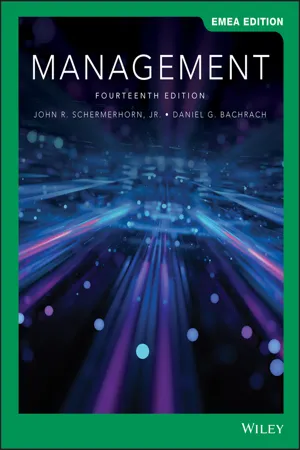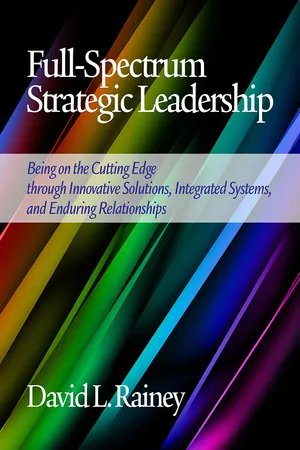Business
Lifestyle and Technological Environment
Lifestyle and technological environment refers to the societal and cultural factors that influence consumer behavior and preferences, as well as the impact of technology on these aspects. It encompasses trends, habits, and attitudes of individuals, as well as the technological advancements that shape their daily lives. Understanding these factors is crucial for businesses to tailor their products and services to meet consumer needs and stay competitive in the market.
Written by Perlego with AI-assistance
Related key terms
1 of 5
8 Key excerpts on "Lifestyle and Technological Environment"
- eBook - PDF
- John R. Schermerhorn, Jr., Daniel G. Bachrach(Authors)
- 2023(Publication Date)
- Wiley(Publisher)
If a business is to compete today and be around in the future, it must innovate at the intersection of environment, technology, and sustainability. Think of the batteries that now power vehicles of all shapes, sizes, and purposes—from cars to trucks to motorcycles to scooters. What once was a promising technological innovation funded by billionaires is now center-stage as a disruptive presence in an intense competitive race. It’s a battle that challenges well-established old-economy corporate giants to innovate or face loss of market domination to nimble startups. Technology and ecology are combining to propel an unprecedented market shift. It’s one that appeals to both financial and sustainability values, and that extends across industries. Investments in cutting-edge technologies are helping businesses of all types create products and provide services in economic, practical, and ecologically sound ways. All this aligns well with growing recognition that extraordinary commitments must be made at all levels of action-indi- vidual, organizational, societal - if we are to preserve our planet for future generations. 78 CHAPTER 4 Environment, Innovation, and Sustainability 4.1 The External Environment LEARNING OBJECTIVE 4.1 Summarize key trends in the external environment of organizations. Learn More About Economic conditions • Legal-political conditions • Sociocultural conditions • Technological conditions • Natural environment conditions The general environment is made up of all external conditions that can impact managerial decision making. Think of it as a broad set of dynamic forces that surround and influence an organization. Figure 4.1 classifies these forces as economic, legal-political, sociocultural, technological, and natural environment conditions. Top managers and C-suite executives have special responsibility for monitoring these conditions and linking them with an organi- zation’s mission, strategy, and activities. - eBook - PDF
- John R. Schermerhorn, Jr., Daniel G. Bachrach(Authors)
- 2020(Publication Date)
- Wiley(Publisher)
If a business is to compete today and be around to com- pete again tomorrow, it must innovate at the intersection of environment, technology, and sustainability. 4.1 The External Environment LEARNING OBJECTIVE 4.1 Summarize key trends in the external environment of organizations. Learn More About Economic conditions • Legal-political conditions • Sociocultural conditions • Technological conditions • Natural environment conditions The general environment is made up of all external conditions that can play a part in manage- rial decision making. You might think of it as a broad set of dynamic forces that surround and influence an organization. Figure 4.1 classifies these forces as economic, legal-political, socio- cultural, technological, and natural environment conditions. Top managers and C-suite exec- utives have special responsibility for monitoring these conditions and linking them with their See Author Video The general environment consists of economic, legal- political, sociocultural, technological, and natural environment conditions in which the organization operates. Economic Environment • economic growth • unemployment rate • disposable income Sociocultural Environment • population demographics • education system • health/nutrition values Legal-Political Environment • laws and regulations • business forms • political trends Natural Environment • “green” values • recycling infrastructure Technological Environment • IT systems/infrastructure • broadband Internet access Organization FIGURE 4.1 Sample elements in the general environments of organizations. The External Environment 71 organization’s mission, strategy, and activities. You can say that their job is to make sure that the voice of the environment gets heard within the organization. Cars like Ford’s Focus Elec- tric and Chevy’s Bolt EV suggest that Ford Motor Company CEO James Hackett and General Motors’ CEO Mary Barra may be listening. - Available until 4 Dec |Learn more
Strategic Marketing
An Introduction
- Tony Proctor(Author)
- 2002(Publication Date)
- Routledge(Publisher)
Organizations need to respond and adapt to changing environmental conditions if they intend to survive. They can even instigate changes in the environment which are in their own interests. Both demand an understanding of those factors and forces which bring about change in the environment. Ideally, an organization should adapt to changes as they occur, even anticipate them in advance or systematically instigate changes to its own advantage. An inability to do so can put organizations in positions where their shor t- and long-term survival is jeopardized. The business environment is the setting within which a business operates, formulates policies and makes decisions. It is usual to distinguish between the inter nal and the exter nal environment. The for mer usually comprises the various assets and resources possessed by the organization. That is its workforce, plant and machiner y, know- how, financial resources, etc. The latter refer s to people, institutions and developments, etc. which exer t an external influence on how the organization performs. Of course, with the emergence of strategic alliances and networks such a definition of boundaries does tend to become more blurred.Firms need to know all about the business environment in which they operate. It is essential that they can anticipate the changes that are likely to take place in the marketing environment in the foreseeable future. However, as noted above, it is not simply a matter of adapting to change. Organizations can also exercise their own influence on the environment. Among the ways that this can be achieved is the development and commercialization of new technological ideas. These new technologies then become par t of the business environment and in their turn have an impact upon what other organizations can do.Considerable control can be exercised over its internal environment by a firm, but a firm cannot exert control in the same way or to the same extent over the external environment. It can only attempt to influence it. There are various ways of influencing events in the external environment. These may include activities such as lobbying among leg islative g roups. The latter is what organizations often do when tr ying to influence the for mulation of European Community directives which can have an impact on such things as product design safety standards, etc. - eBook - PDF
- Ricky Griffin(Author)
- 2021(Publication Date)
- Cengage Learning EMEA(Publisher)
Cengage Learning reserves the right to remove additional content at any time if subsequent rights restrictions require it. 65 CHAPTER 3 | UNDERSTANDING THE ORGANIZATION’S ENVIRONMENT of digital technology into all areas of business is also a reflection of the technological dimension. Another recent advancement is the rapid growth of integrated business software systems. The Doing Business on Planet Earth feature illustrates another connection between technology and business. The Sociocultural Dimension The sociocultural dimension of the general environment includes the customs, mores, values, and demographic characteristics of the society in which the organization functions. Sociocultural processes are important because they determine the products, services, and standards of conduct that the society is likely to value. In some countries, for example, consumers are willing to pay premium prices for designer clothes, whereas the same clothes have virtually no market in other countries. Consumer tastes also change over time. Preferences for color, style, taste, and so forth change from season to season, for example. Drinking hard liquor and smoking cigarettes are less common in the United States today than they were just a few years ago. And sociocultural factors influence how workers in a society feel about their jobs and organizations. Appropriate standards of business conduct also vary across cultures. In the United States, accepting bribes and bestowing political favors in return are considered unethical (as well as illegal). In other countries, however, payments to local politicians may be expected in return for a favorable response to such common business transactions as applications for zoning and operating permits. The shape of the market, the ethics of political influence, and attitudes in the workforce are only a few of the many ways in which culture can affect an organization. Figure 3.2 shows that McDonald’s is clearly affected by sociocultural factors. - eBook - PDF
- David L. Rainey(Author)
- 2008(Publication Date)
- Information Age Publishing(Publisher)
Such products and services have to enhance lifestyle and make living more enjoyable. And they are now much more feasible and profitable given the significantly larger numbers of people over sixty-five. Lifestyle is a complicated notion used to characterize how people live. It pertains to all people, but it is significantly more in line with people living in the high-income countries (incomes over US$20,000 per capita). People with high levels of disposable income have many more choices in what they decide to buy and what they do. Lifestyle describes the general patterns of people’s behavior, their day-to-day activities, and their attitudes about living. While lifestyle includes a wide range of social and cultural con- siderations, it typically involves one’s decisions and actions pertaining to education, employment, leisure time, household formation, living arrangements and numerous other elements of life. Appreciating lifestyle considerations means understanding the patterns of living and the underlying business opportunities that they create. Historically, strategic leaders viewed the sale and consumption of goods and ser- vices as the critical factors for business success. Thus, they focused on the demand for more elaborate products and services, especially ones with high margins. This think- ing skewed decision making toward people in high income countries that have high 50 Full-Spectrum Strategic Leadership consumption levels and high levels of disposable incomes. But trying to encourage even higher levels of consumption has positive and negative implications in today’s business world. The positive aspects include known market demand, excellent turn- over, and good cash flow. The negative aspects involve saturated markets, low growth rates, depletion of resources, and the possible decline in overall personal wealth as people convert their incomes and savings into short-term pleasures. - eBook - PDF
- Paul Beynon-Davies(Author)
- 2017(Publication Date)
- Red Globe Press(Publisher)
193 7 e Business environment Learning outcomes Principles Understand the relationship between the organisation as a system and the environment of the organisation. The organisation as a value-creating system interacts with actors within the wider environment. It is useful to consider four major aspects of this environment: economic, social, political and physical. Describe the nature of the economic environment of the organisation. The primary environment of a commercial organisation is the economy. Economies are systems for coordinating the production and distribution of goods/products and services. Commerce is the term normally used for that process which deals with the exchange of goods and services from producer to final consumer. Describe the nature of the social environment of the organisation. There is clear evidence that modern Western societies are now information societies. The definition of the information society relies on a critical mass of the populace using what we have called electronic delivery as their preferred method of accessing the services and products of public and private sector organisations. A number of pre-conditions exist to the successful uptake of electronic delivery: awareness, interest, access, skills, use and impact. Understand the political environment of the organisation. Traditional conceptions of law are being challenged by electronic commerce, such as the use and enforcement of contracts and intellectual property rights. Describe the nature of the physical environment of the organisation. Any activity has an impact upon the physical environment. An increasing focus has been given to the proper management of ICT to mitigate effects upon the physical environment and to reduce an organisation’s carbon footprint. - eBook - PDF
- John R. Schermerhorn, Jr., Daniel G. Bachrach, Barry Wright(Authors)
- 2020(Publication Date)
- Wiley(Publisher)
It’s a race that challenges well- established old-economy corporate giants to innovate or face loss of market domination. And this is a loss they’re not pre- pared to suffer. Technology and ecology are now combining to propel, through innovation, an unprecedented, even revolutionary, sylv1rob1/Shutterstock.com The External Environment 63 What to Look for Inside Management Is Real 4.1 Analysis Make Data Your Friend Social Attitudes Shift on Women at Work, but Concerns for Equality Persist 4.2 Ethics Know Right from Wrong Offshore E-Waste Graveyards Bury a Problem 4.3 Insight Keep Learning about Yourself Risk Taking Has Its Ups and Downs 4.4 Wisdom Learn from Role Models The Westons Take the Cake 4.5 Choices Think before You Act Sustainability Ranks Low among Global Executive Challenges Skills That Make You Valuable • Evaluate Career Situations: What Would You Do? • Reflect on the Self-Assessment: Tolerance for Ambiguity • Contribute to the Class Exercise: The Future Workplace • Manage a Critical Incident: It’s Also about Respect • Collaborate on the Team Activity: Organizational Commitment to Sustainability Scorecard • Analyze the Case Study: Patagonia | Leading a Green Revolution Chapter Quick Start We live in a complex and dynamic environment that presents a continual stream of problems and opportunities to us as individuals, to the organizations in which we work, and to society at large. Managers need to understand the environment in order to help lead their organi- zations to create value for society, accomplish innovation, and contribute to sustainability. 4.1 The External Environment LEARNING OBJECTIVE 4.1 Summarize key trends in the external environment of organizations. Learn More About Economic conditions • Legal-political conditions • Socio-cultural conditions • Technological condi- tions • Natural environment conditions The external environment of organizations consists of all external conditions that set the context for managerial decision-making. - eBook - ePub
People Practice
A Complete Guide
- Karen Waite, Kathy Beevers, Nicky Small, Keith Tomlinson, Shazad Hussain(Authors)
- 2021(Publication Date)
- CIPD - Kogan Page(Publisher)
There is a popular saying that ‘nothing is more constant than change’ and we agree; change is inevitable. It is also true to say that, as in the quote above, a significant amount of change is outside our control. However, most organisations do have the option to stay aware, predict changes to some extent and ensure that as much as possible, they are prepared for these. People professionals and managers have a major part to play in this, whether it is ensuring an appropriate workforce, developing new people systems or supporting employee upskilling and general well-being.In this chapter we explore different aspects of how organisations work and the many factors that impact their business environment. We also consider how people behave in organisations and how we, as people professionals, can support and contribute to the positive and effective management of change.Why we need to understand the business environment
When we use the term ‘environment’, it is to describe something that is all around us, ie … the circumstances, objects, or conditions by which one is surrounded.We can therefore define ‘business environment’ as:The sum or collection of all internal and external factors such as employees, customers, management, clients, suppliers, owners, activities by government, innovation in technology, social trends, market trends and economic changes.If we consider some of the organisations we know, and what has impacted or created pressure points on their business, we might think of political changes such as Brexit in the UK, world events such as Covid-19, ongoing technological developments, or maybe factors affecting staff such as skills shortages. Just this simple quick consideration reminds us of how turbulent and ever-changing the business environment can be and therefore the need for organisations to manage this turbulence if they are to survive and prosper.We can refer to the business environment as operating at two levels – macro and micro. Macro level refers to the societal level and the major uncontrollable external forces (economic, demographic, technological, social and cultural, legal and political) which will influence a company’s decision-making and impact its performance. Micro level is specific to an organisation’s internal and immediate environment, factors such as its suppliers, customers, competitors and resellers, which directly influence it on a regular basis. The micro level is sometimes also known as ‘the task environment’ as this is usually the area where an organisation can influence and respond, whereas it has very little control over the macro environment.
Index pages curate the most relevant extracts from our library of academic textbooks. They’ve been created using an in-house natural language model (NLM), each adding context and meaning to key research topics.







